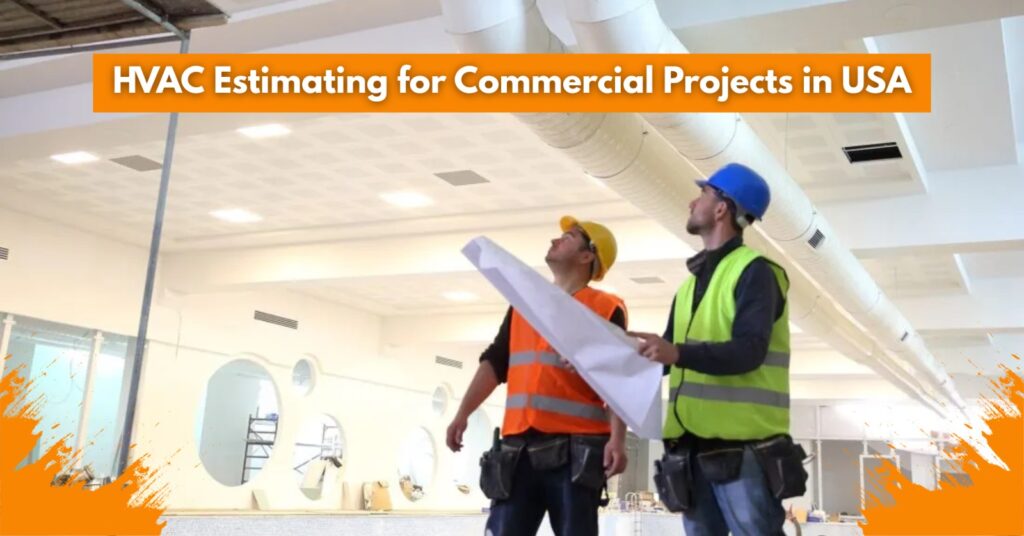You are on a job site in Chicago, and blueprints are spread across a folding table, on which coffee is going cold. The deadline to submit your bid is the very next day. You’ve counted the duct runs twice, priced the rooftop units, and still feel less confident. What if you missed the seismic bracing? What if steel prices jumped again this week? One wrong number and you either lose the job or lose your shirt trying to build it. That’s the reality for too many contractors chasing commercial HVAC estimating in the USA.
These are bigger structures, costly, and the room for mistakes is thin. But here’s the truth: when you understand the scope, nail the cost drivers, and follow a proven workflow, you don’t just bid. You win. And you keep the profit. This guide provides you with every detail you need to estimate commercial HVAC projects like a seasoned mechanical estimating company.
What “Commercial HVAC” Actually Means
Before you price a single elbow fitting, you have to know what you’re estimating. Commercial HVAC isn’t residential on steroids. It requires each thing to be well calculated. The commercial projects usually range from 20,000 to over 500,000 square feet, with different needs such as offices needing quiet and comfortable space, hospitals demanding redundancy, and warehouses prioritizing ventilation over comfort.
Your estimate must include:
- Heating and cooling equipment
The equipment is rooftop units (RTUs), air handlers, chillers, boilers, and VRF systems. These systems provide temperature control and conditioning throughout the facility. - Air distribution
It comprises sheet metal and flex ducts, diffusers, grilles, VAV boxes, and fire dampers. They ensure efficient air delivery, flow regulation, and safety compliance. - Piping
Piping is used for chilled water, hot water, as a refrigerant, and condenser. These systems circulate liquid for heating, cooling, and dehumidification - Controls
Encompasses thermostats, DDC systems, BACnet integration, and energy management platforms. Controls maintain indoor comfort while optimizing system performance and efficiency. - Ancillary items
Includes roof curbs, access doors, vibration isolation, and testing and balancing (TAB). These items ensure that all HVAC systems operate per design with standard performance.
For example, an office building of 100,000 square feet in a moderate climate, total HVAC costs usually range between $1.5 million and $3 million. That breaks down to $15 to $30 per square foot, though high-rise labs or data centers can push $40+ per square foot.

The Four Cost Drivers That Decide If You Win or Lose
Your final bid number isn’t random. It’s shaped by four forces that together make up 80% of the total. Miss even one, and you’ll either price yourself out of the job or eat the overrun yourself.
1. Equipment Choice: The Biggest Swing Factor
What you pick, make the baseline. A basic 50ton RTU runs about $60,000 fully installed. Upgrade to a chiller system with cooling towers and pumps? That same capacity jumps past $400,000. VRF setups promise energy savings but hit 30–50% harder upfront than standard DX factor that early. Chillers price out at $5–$10 per CFM for water-cooled models in 2025, towers, and pumps included.
2. Ductwork Material and Layout: The Hidden Budget Eater
Duct runs swallow 25–35% of every dollar. Standard galvanized sheet metal holds the line at $10–$15 per linear foot with hangers, sealant, and labor. Spiral round costs $12–$18/LF but drops install time and leakage—worth it on tight schedules. Flex duct tempts at $3–$6/LF, yet codes often ban it in returns or visible spots; check your local IMC add-ons every time.
3. Building Height and Site Access: Labor’s Silent Killer
Ground-level retail is straightforward. Stack 15 floors and everything changes—cranes, scissor lifts, and rigging push labor 20–40% higher. Roof access, vertical shafts, and hoist paths decide how many hours your crew actually works versus waiting. Walk the site before takeoff; a narrow shaft can turn a two-week duct install into four.
4. Energy Codes and Green Mandates: The Non-Negotiable Add-On
IECC 2021 (plus state tweaks) forces variable-speed drives, ECM motors, and heat-recovery units into every design. That tacks 10–20% onto equipment, but rebates and LEED credits soften the blow long-term. California Title 24 demands control ventilation and full commissioning, and budget an extra $1.50–$3.00 per square foot in those markets.

The Proven Workflow: From Blank Plans to Final Bid
Professional estimators follow a process of 6 steps. Master this, and you’ll cut takeoff time in half while boosting accuracy.
Step 1: Load Calculation and System Sizing
Start with ACCA Manual J or energy modeling software like TRACE 700. Input occupancy, lighting loads, envelope details, and climate data. Oversizing by 20% wastes capital; undersizing triggers callbacks.
Step 2: Digital Takeoff: The Power of Precision
Manual counting is dead. Use Bluebeam Revu, PlanSwift, or STACK to measure every duct run, fitting, and diffuser directly on PDFs. A 100,000 square foot project might have 5,000 linear feet of duct and 800 fittings. Digital tools catch 99% of items in under 8 hours.
Step 3: Material Pricing: Stay Current
Material pricing, such as steel, copper, and refrigerant prices, changes weekly. Use updated RSMeans or Craftsman Cost books for 2025. Keep yourself updated and try to lock in vendor quotes early.
Step 4: Labor Hours: The Real Profit Killer
The HVAC labor rate in the USA varies by region and union status. Field technicians earn $25–$35 per hour take-home; billed rates range $70–$150 per hour. Add each installation labor as well as add 15% for overhead (insurance, trucks, tools) and 10% contingency for rework.
Step 5: Overhead, Profit, and Contingency
Typical breakdown includes materials (40%), labor (40%), equipment (15–20), and overhead (10–15%). Profit markup is usually 15–35% on materials, 8–12% on labor.
Step 6: Review and Submit
Peer review catches 90% of errors. Compared to historical jobs. Your 80,000 sq. ft. office last year came in at $18.40/sq. ft. If this bid hits $24, justify every dollar.

HVAC Estimating Mistakes
Even sharp contractors bleed money on preventable mistakes. Here are the top five culprits.
1. Forgetting Controls and Commissioning
A $2 million system without DDC controls? Useless. Controls add 10–18% to cost. Commissioning required by code in most states adds another 3–5%. Line-item both or eat the change order.
2. Using Outdated Cost Data
Copper jumped 12% in 2024. If your database is stale, you’re bidding blind. Update quarterly minimum.
3. Manual Takeoff Errors
Hand-measured plans miss transitions, offsets, and access panels. One missed 24×12 reducer can cost $800 installed.
4. Ignoring Site Conditions
Tight mechanical rooms, phased construction, or nighttime work rules add hours. Visit the site every time.
5. No Allowance for Testing and Balancing (TAB)
Air and water balancing ensure performance. Budget $0.75–$1.50 per sq. ft. Skipping it voids warranties.
Regional Cost Variations Across the USA
Location isn’t just weather. It’s labor, codes, and supply chains. The usual range of costs is as follows.
| Region | Labor Rate (Billed) | Duct Cost (Installed) | Code Impact |
|---|---|---|---|
| Northeast | $110–$150/hr | $14–$18/LF | High (IECC + local) |
| Southeast | $70–$100/hr | $10–$13/LF | Moderate |
| Midwest | $80–$120/hr | $11–$15/LF | Moderate |
| West Coast | $120–$160/hr | $15–$20/LF | Very High (Title 24) |
| Mountain West | $75–$110/hr | $10–$14/LF | Low-Moderate |

Conclusion
Mastering commercial HVAC estimating means winning more bids and keeping more profit. By defining scope clearly, controlling equipment choices, duct design, site access, and energy codes, you eliminate guesswork. Follow the proven six-step workflow: takeoff, price, labor, markup, review, and you’ll cut errors by 90%. Avoid the five common traps, like skipping controls or stale pricing, and every job stays on budget. Real contractors have turned $100k losses into 18% margins using these exact steps. Start today: review your last bid, apply this system, and watch margins grow.
Stop Guessing. Start Winning. Get Your Estimate Done. ALM Estimating delivers fast, accurate HVAC estimating services in the USA. Get your detailed quote now.
FAQs
Q1. How much does commercial HVAC cost per square foot in the USA in 2025?
Expect $15–$30 for standard office or retail builds. Hospitals, labs, and data centers range $35–$50 per square foot due to redundancy and filtration.
Q2. What percentage of a commercial project budget goes to HVAC?
Typically, 12–18% of total construction cost, higher in cold climates or high-ventilation buildings like kitchens.
Q3. How long does a professional HVAC estimate take?
With digital tools and complete plans, 1–3 days for projects under 150,000 sq. ft. Larger or complex jobs take 5–7 days.
Q4. What’s the most overlooked item in HVAC estimates?
Commissioning and controls. Many contractors remember equipment but forget the brains that make it work.
